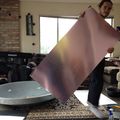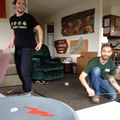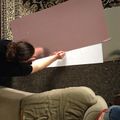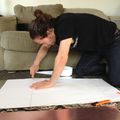Clay Smeback (talk | contribs) mNo edit summary |
m (Standardize wikitext) |
||
| (73 intermediate revisions by 9 users not shown) | |||
| Line 1: | Line 1: | ||
[[File:2018 Solar Cooker Testing and Chilling 16.JPG|thumb]] | |||
[[File: | |||
{{Project data | |||
| authors = Jay Nutt, Clay Smeback, Roger Hess | |||
| cost = USD 81.25 | |||
| location = Arcata, California | |||
}} | |||
Parabolic solar cookers are designed to utilize the sun's vast supply of energy to do what we all need to do from time to time, cook food! Instead of cranking up the gas oven or turning on an electric stove, we can harness the sun's energy to focus light to generate enough heat to make food, or even distill water. | |||
This project was originally inspired by Bart Orlando in Spring of 2018, for a class project in Appropiate Technology Course at Cal Poly Humboldt. | |||
== Problem statement == | |||
The objective of this project was to make a solar cooker with Bart Orlando as the client. The idea of solar cookers has been around for quite some time now. One of the biggest appeals of solar cookers is that there are no indoor air quality health effects associated with the use of them. This appeal has inspired people like Bart Orlando to try to to produce solar cookers at a scale that could be implemented into developing countries to combat carbon intensive wood burning cook stoves and other cooking methods that produce greenhouse gases as a by product. | |||
== Project Evaluation Criteria == | |||
The following Criteria will be used to assess the success of this project. These criteria were chosen based on the suggestions of the project coordinator as well as the diligent students who are working on the catchment system. The scale (1-10) represents the importance level of meeting the constraint of each listed criteria. | |||
{| class="wikitable sortable" | |||
! Criteria | |||
! Constraints | |||
! Weight (1-10) | |||
|- | |||
| Safety | |||
| Must be located in an area that makes it so that has no potential fire hazard. Must be equipped with adequate protective gear such as sunglasses, gloves and a tarp. | |||
| 10 | |||
|- | |||
| Maintainability | |||
| Must be easy to clean and have adequate supplies to prevent scratching of the mirrors. | |||
| 4 | |||
|- | |||
| Aesthetics | |||
| Must be pleasing to the eye and look professional | |||
| 4 | |||
|- | |||
| Storability | |||
| Must have the option to break down the solar cooker in order to be able to store the solar cooker in a reasonably small area. | |||
| 7 | |||
|- | |||
| Efficiency | |||
| Must be able to boil water on a completely sunny day and also light a 2 by 4 beam on fire. | |||
| 10 | |||
|- | |||
| Usability | |||
| Must be able to give brief instructions on how to use the solar cooker. | |||
| 7 | |||
|- | |||
| Portability | |||
| Must be able to fit in the back of a the average sized pickup truck. | |||
| 8 | |||
|- | |||
| Cost | |||
| Must not exceed budget | |||
| 9 | |||
|} | |||
== Literature Review == | == Literature Review == | ||
This is | This is a review of the available literature pertinent to the a specific project. | ||
=== Solar Cooker Basics === | |||
The more reflective the material used for a solar cooker's surface, the more energy from the sun will be converted directly to the focal point to generate heat. True mirrors have the highest potential of converting light into heat. Reflective aluminum is another great material to use that will be about 95% efficient. However, the material is only one aspect of the cooker. Forming the correct shape so that all the energy is directed to one point is an essential aspect of the solar cooker. | |||
=== Parabolas and Paraboloids === | |||
The three dimensional parabola, the paraboloid, is the most efficient shape for solar cookers. Unlike box solar ovens, the parabolic shape has a central focal point where any light that hits the parabola’s walls will reflect into it. Using sunlight, the heat, along with the light, will reflect into that focal point and warm that spot. The cooking container should be located at the focal point so the maximum amount of heat will be used for cooking. With the general equation for a parabola being: | |||
<math>y=x^2</math> | |||
the focal point can be found by taking a point on the curve, (x, y) and putting it into the equation: | |||
<math>a=x^2/4y</math> | |||
with the variable, a as the focus (Stein, 1999).<ref>“Parabolic Basket and Tin Can Solar Cooker.” Conventional Farming - Appropedia: The Sustainability Wiki, ENGR 305 , 23 June 2017, www.appropedia.org/Parabolic_basket_and_tin_can_solar_cooker..</ref> | |||
=== Humboldt County Weather === | |||
The amount of clear days in Humboldt County is the major inconvenience with local solar cooking. Arcata has around 78 completely clear days per year with the most during September and October and a monthly average of 6.5 clear days (Western Regional Climate Center). Although most days are not completely clear, there are still partly cloudy days where it will clear up long enough to cook something around midday to early afternoon. This inconvenience of weather in Humboldt County became one of our projects largest obstacles.<ref>“Parabolic Basket and Tin Can Solar Cooker.” Conventional Farming - Appropedia: The Sustainability Wiki, ENGR 305 , 23 June 2017, www.appropedia.org/Parabolic_basket_and_tin_can_solar_cooker..</ref> | |||
== Project goals == | == Project goals == | ||
| Line 23: | Line 86: | ||
To make a numbered list use the pound sign: | To make a numbered list use the pound sign: | ||
# | |||
# | # Build solar cooker | ||
# | # Stay within budget | ||
# Boil 1 liter of water | |||
== Design == | == Design == | ||
Our design for a shallow parabolic solar cooker was made by fixing mirrored aluminum panels to an existing aluminium satellite dish and using wood poles to hag our cast iron pot over it. We took Bart Orlandos' advice and checked out the Arcata scrap yard to see if there were any dishes we could utilize. We ended up finding an old 4ft diameter and a 8 inch deep aluminum dish at the scrap yard. There are definitely some disadvantages to the dish we ended up using. It would be best if the dish had a larger diameter and was deeper. This is because the percent of area that the cooking pot shades the dish will be a smaller fraction of the total area of the dish as the diameter of the dish increases. The problem with having a shallow dish is that the dish can be a safety hazard and start fires with tall trees that are in the vicinity of the dish on a sunny day. These dimensions made our focal point be 1.5ft away from the bottom of the dish. Once we found our dish we got sheets of engineering paper that were big enough for us to draw out different shapes of our mirrored aluminum panels. We ended up choosing to go with a shape that would maximize the diameter of mirrors on the dish, but leave about a 3 inch diameter hole in the middle. We cut the mirrors with an angle grinder. The angle grinder worked well and allowed us to cut straight, but had rough edges that needed to get filed down. In order to get the mirror to stay on the dish we decided that bolting down the mirrors was our best option that we had available. When bolting the mirrors onto the dish we had one member drilling holes into the mirror and the dish, another member that was holding down the mirror and using a blow dryer to blow away metal shavings and the last member was screwing the bolts into the dish. After constructing the dish we had to go about making a stand for our dish. We used the wood poles to make a pyramid like shape above our dish by tying a knot called overlay fisherman on the top of the wood poles and then hung our cast iron pot so that the bottom of the pot is right over the focal point. When testing with the dish we used wood logs, a guitar stand and 15 feet of 550 cord to prop up the dish so that it was pointed at the sun. When testing with our solar cooker the weather became a constraint in our ability to boil water. With the weather being partly cloudy when we tested we were able to heat our water to 123.5 degrees Fahrenheit. | |||
< | <gallery> | ||
File:2018 solar cooker new mirrors 01.jpeg|Fig 1: Uncut sheet of Reflective Aluminum | |||
File: | File:2018 solar cooker washing dish 02.jpg|Fig 2: Washing Satellite Dish | ||
File: | File:2018 solar cooker smoothing out dish 03.jpeg | Fig 3: Using an angle grinder to smooth out protruding bolts on satellite dish | ||
File: | File:2018 Solar Cooker work day 1 04 .JPG | Fig 4: Setting up our workstation | ||
File:2018 solar cooker work day 1 05.JPG |Fig 5: Setting up our work station | |||
File:2018 Solar Cooker Measuring 06.jpeg | Fig 6: Measuring and drawing cut lines for paper prototype | |||
File:2018 Solar Cooker Measuring 07.jpeg | Fig 7: More measuring | |||
File:2018 Solar Cooker Final Prototype mirror shape 09.jpg | Fig 8: Final paper prototype | |||
File:2018 Solar Cooker Measuring 08.jpeg | Fig 9: Reflective aluminum all measured out! | |||
File:2018 Solar Cooker Roger with dish 10.jpeg | Fig 10: Setting up to install mirrors | |||
File:2018 Solar Cooker Cut mirror 11.JPG | Fig 11: Mirrors cut to shape | |||
File:2018 Solar Cooker Lining them up 12.JPG | Fig 12: Lining 'em up! | |||
File:2018 Solar Cooker Mid construction 13.jpeg | Fig 13: Mid construction | |||
File:2018 Solar Cooker Observing 14.jpeg | Fig 14: Mid construction | |||
File:2018 Solar Cooker Finished Product 15.JPG | Fig 15: Complete! | |||
File:2018 Solar Cooker Testing and Chilling 16.JPG | Fig 16: An exercise in futility: too cloudy. | |||
File:2018 Solar Cooker testing 17.jpeg | Fig 17: Stuntin' | |||
</gallery> | </gallery> | ||
=== | === Materials and Tools === | ||
{{Columns|start}} | |||
* 4 ft in diameter old aluminum satellite dish | |||
* 3 sheets of 2ft by 4ft reflective aluminum sheet metal | |||
* Cast iron pot | |||
* 80 bolts and nuts | |||
* 3 10ft wood poles | |||
* 50ft of 550 cord | |||
* Guitar stand | |||
{{Columns|break}} | |||
* 2 sawhorses | |||
* Angle grinder | |||
* 2 drills with metal drill bits | |||
* Chisel | |||
* File | |||
{{Columns|break}} | |||
* Protective eye gear | |||
* Dust mask | |||
* Gloves | |||
* ear plugs | |||
* Close toed shoes | |||
{{Columns|end}} | |||
== Budget == | == Budget == | ||
This budget is an estimation of the monetary costs anticipated in the construction of a parabolic solar cooker. | |||
This budget is an estimation of the monetary costs anticipated in the construction of a parabolic solar cooker. | |||
{| class="wikitable sortable" | {| class="wikitable sortable" | ||
! Quantity | ! Quantity | ||
! Material | |||
! Source | |||
! Cost ($) | |||
! Total ($) | |||
|- | |||
| 3 | |||
| 2x4 Mirrored Aluminum Sheets | |||
| Lonny | |||
| Donation | |||
| Free | |||
|- | |||
| 1 | |||
| Box of 100 1/2" Hex Bolts | |||
| Ace Hardware | |||
| 10.00 | |||
| 10.00 | |||
|- | |||
| 1 | |||
| Box of 100 1/2" Hex Nuts | |||
| Ace Hardware | |||
| 8.00 | |||
| 8.00 | |||
|- | |||
| 1 | |||
| Box of Aluminum Foil | |||
| Safeway | |||
| 3.25 | |||
| 3.25 | |||
|- | |- | ||
| 1 | |||
| Cast Iron Cook Pot | |||
| Clay's Garage | |||
| Donation | |||
| 1 | | Free | ||
| | |- | ||
| 1 | |||
| Guitar Stand | |||
| Jay's Place | |||
| Donation | |||
| Free | |||
|- | |- | ||
| 1 | | 1 | ||
| | | Butcher Paper | ||
| Engineering Lab | |||
| | | Donation | ||
| Free | |||
|- | |||
| 1 | |||
|- | | 4' Satellite Dish | ||
| | | Arcata Scrap Yard | ||
| 60.00 | |||
| 60.00 | |||
| | |- class="sortbottom" | ||
| | | colspan="4" align="right" |'''Total Cost''' | ||
! $81.25 | |||
|- | |||
| 1 | | |||
| | |||
| | |||
|-class="sortbottom" | |||
|colspan="4" align="right" | '''Total Cost''' | |||
|} | |} | ||
== | == Conclusions == | ||
From an appropriate technology stance, solar cookers are not very ideal for the Pacific Northwest Region. The reason for this is that the amount of sunlight in a given day is typically very limited as it is generally mostly overcast. This exactly happened when we tested our solar cooker. We tested the cooker at 1:00pm on May 6, 2018 with it being sixty degrees and partly cloudy. Once we put our liter of water we were testing with into the cast iron pot we were able to get the water to 123.5 degrees Fahrenheit. This was only a couple of minutes into our testing when the sun we had over head in the sky became covered up by heavy cloud coverage. Cloud coverage like we experienced when testing with our solar cooker impedes the ability for solar energy in the form of sunlight to reach the solar cooker and generate enough heat to boil water. | |||
== Next steps == | |||
* Further develop stand design and cast iron pot holder. | |||
* Expand testing data by cooking different foods in climatically diverse conditions. | |||
* Find a home for the solar cooker or deliver to Bart Orlando. | |||
== References == | == References == | ||
<references /> | |||
<references/> | |||
== Contact details == | == Contact details == | ||
* Jay Nutt - jcn5@humboldt.edu | |||
* Clay Smeback - wcs62@humboldt.edu | |||
* Roger Hess - rwh202@humboldt.edu | |||
{{Page data | |||
| keywords = Mirrored Aluminum Sheets, Guitar Stand, Satellite Dish | |||
| sdg = SDG09 Industry innovation and infrastructure | |||
| license = CC-BY-SA-3.0 | |||
| language = en | |||
}} | |||
Latest revision as of 19:44, 8 June 2023
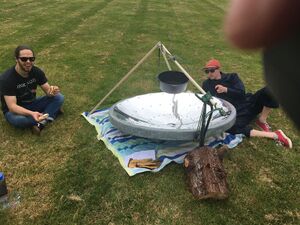
Parabolic solar cookers are designed to utilize the sun's vast supply of energy to do what we all need to do from time to time, cook food! Instead of cranking up the gas oven or turning on an electric stove, we can harness the sun's energy to focus light to generate enough heat to make food, or even distill water.
This project was originally inspired by Bart Orlando in Spring of 2018, for a class project in Appropiate Technology Course at Cal Poly Humboldt.
Problem statement[edit | edit source]
The objective of this project was to make a solar cooker with Bart Orlando as the client. The idea of solar cookers has been around for quite some time now. One of the biggest appeals of solar cookers is that there are no indoor air quality health effects associated with the use of them. This appeal has inspired people like Bart Orlando to try to to produce solar cookers at a scale that could be implemented into developing countries to combat carbon intensive wood burning cook stoves and other cooking methods that produce greenhouse gases as a by product.
Project Evaluation Criteria[edit | edit source]
The following Criteria will be used to assess the success of this project. These criteria were chosen based on the suggestions of the project coordinator as well as the diligent students who are working on the catchment system. The scale (1-10) represents the importance level of meeting the constraint of each listed criteria.
| Criteria | Constraints | Weight (1-10) |
|---|---|---|
| Safety | Must be located in an area that makes it so that has no potential fire hazard. Must be equipped with adequate protective gear such as sunglasses, gloves and a tarp. | 10 |
| Maintainability | Must be easy to clean and have adequate supplies to prevent scratching of the mirrors. | 4 |
| Aesthetics | Must be pleasing to the eye and look professional | 4 |
| Storability | Must have the option to break down the solar cooker in order to be able to store the solar cooker in a reasonably small area. | 7 |
| Efficiency | Must be able to boil water on a completely sunny day and also light a 2 by 4 beam on fire. | 10 |
| Usability | Must be able to give brief instructions on how to use the solar cooker. | 7 |
| Portability | Must be able to fit in the back of a the average sized pickup truck. | 8 |
| Cost | Must not exceed budget | 9 |
Literature Review[edit | edit source]
This is a review of the available literature pertinent to the a specific project.
Solar Cooker Basics[edit | edit source]
The more reflective the material used for a solar cooker's surface, the more energy from the sun will be converted directly to the focal point to generate heat. True mirrors have the highest potential of converting light into heat. Reflective aluminum is another great material to use that will be about 95% efficient. However, the material is only one aspect of the cooker. Forming the correct shape so that all the energy is directed to one point is an essential aspect of the solar cooker.
Parabolas and Paraboloids[edit | edit source]
The three dimensional parabola, the paraboloid, is the most efficient shape for solar cookers. Unlike box solar ovens, the parabolic shape has a central focal point where any light that hits the parabola’s walls will reflect into it. Using sunlight, the heat, along with the light, will reflect into that focal point and warm that spot. The cooking container should be located at the focal point so the maximum amount of heat will be used for cooking. With the general equation for a parabola being:
the focal point can be found by taking a point on the curve, (x, y) and putting it into the equation:
with the variable, a as the focus (Stein, 1999).[1]
Humboldt County Weather[edit | edit source]
The amount of clear days in Humboldt County is the major inconvenience with local solar cooking. Arcata has around 78 completely clear days per year with the most during September and October and a monthly average of 6.5 clear days (Western Regional Climate Center). Although most days are not completely clear, there are still partly cloudy days where it will clear up long enough to cook something around midday to early afternoon. This inconvenience of weather in Humboldt County became one of our projects largest obstacles.[2]
Project goals[edit | edit source]
Describe project goals here.
To make a numbered list use the pound sign:
- Build solar cooker
- Stay within budget
- Boil 1 liter of water
Design[edit | edit source]
Our design for a shallow parabolic solar cooker was made by fixing mirrored aluminum panels to an existing aluminium satellite dish and using wood poles to hag our cast iron pot over it. We took Bart Orlandos' advice and checked out the Arcata scrap yard to see if there were any dishes we could utilize. We ended up finding an old 4ft diameter and a 8 inch deep aluminum dish at the scrap yard. There are definitely some disadvantages to the dish we ended up using. It would be best if the dish had a larger diameter and was deeper. This is because the percent of area that the cooking pot shades the dish will be a smaller fraction of the total area of the dish as the diameter of the dish increases. The problem with having a shallow dish is that the dish can be a safety hazard and start fires with tall trees that are in the vicinity of the dish on a sunny day. These dimensions made our focal point be 1.5ft away from the bottom of the dish. Once we found our dish we got sheets of engineering paper that were big enough for us to draw out different shapes of our mirrored aluminum panels. We ended up choosing to go with a shape that would maximize the diameter of mirrors on the dish, but leave about a 3 inch diameter hole in the middle. We cut the mirrors with an angle grinder. The angle grinder worked well and allowed us to cut straight, but had rough edges that needed to get filed down. In order to get the mirror to stay on the dish we decided that bolting down the mirrors was our best option that we had available. When bolting the mirrors onto the dish we had one member drilling holes into the mirror and the dish, another member that was holding down the mirror and using a blow dryer to blow away metal shavings and the last member was screwing the bolts into the dish. After constructing the dish we had to go about making a stand for our dish. We used the wood poles to make a pyramid like shape above our dish by tying a knot called overlay fisherman on the top of the wood poles and then hung our cast iron pot so that the bottom of the pot is right over the focal point. When testing with the dish we used wood logs, a guitar stand and 15 feet of 550 cord to prop up the dish so that it was pointed at the sun. When testing with our solar cooker the weather became a constraint in our ability to boil water. With the weather being partly cloudy when we tested we were able to heat our water to 123.5 degrees Fahrenheit.
-
Fig 1: Uncut sheet of Reflective Aluminum
-
Fig 2: Washing Satellite Dish
-
Fig 3: Using an angle grinder to smooth out protruding bolts on satellite dish
-
Fig 4: Setting up our workstation
-
Fig 5: Setting up our work station
-
Fig 6: Measuring and drawing cut lines for paper prototype
-
Fig 7: More measuring
-
Fig 8: Final paper prototype
-
Fig 9: Reflective aluminum all measured out!
-
Fig 10: Setting up to install mirrors
-
Fig 11: Mirrors cut to shape
-
Fig 12: Lining 'em up!
-
Fig 13: Mid construction
-
Fig 14: Mid construction
-
Fig 15: Complete!
-
Fig 16: An exercise in futility: too cloudy.
-
Fig 17: Stuntin'
Materials and Tools[edit | edit source]
|
|
|
Budget[edit | edit source]
This budget is an estimation of the monetary costs anticipated in the construction of a parabolic solar cooker.
| Quantity | Material | Source | Cost ($) | Total ($) |
|---|---|---|---|---|
| 3 | 2x4 Mirrored Aluminum Sheets | Lonny | Donation | Free |
| 1 | Box of 100 1/2" Hex Bolts | Ace Hardware | 10.00 | 10.00 |
| 1 | Box of 100 1/2" Hex Nuts | Ace Hardware | 8.00 | 8.00 |
| 1 | Box of Aluminum Foil | Safeway | 3.25 | 3.25 |
| 1 | Cast Iron Cook Pot | Clay's Garage | Donation | Free |
| 1 | Guitar Stand | Jay's Place | Donation | Free |
| 1 | Butcher Paper | Engineering Lab | Donation | Free |
| 1 | 4' Satellite Dish | Arcata Scrap Yard | 60.00 | 60.00 |
| Total Cost | $81.25 | |||
Conclusions[edit | edit source]
From an appropriate technology stance, solar cookers are not very ideal for the Pacific Northwest Region. The reason for this is that the amount of sunlight in a given day is typically very limited as it is generally mostly overcast. This exactly happened when we tested our solar cooker. We tested the cooker at 1:00pm on May 6, 2018 with it being sixty degrees and partly cloudy. Once we put our liter of water we were testing with into the cast iron pot we were able to get the water to 123.5 degrees Fahrenheit. This was only a couple of minutes into our testing when the sun we had over head in the sky became covered up by heavy cloud coverage. Cloud coverage like we experienced when testing with our solar cooker impedes the ability for solar energy in the form of sunlight to reach the solar cooker and generate enough heat to boil water.
Next steps[edit | edit source]
- Further develop stand design and cast iron pot holder.
- Expand testing data by cooking different foods in climatically diverse conditions.
- Find a home for the solar cooker or deliver to Bart Orlando.
References[edit | edit source]
- ↑ “Parabolic Basket and Tin Can Solar Cooker.” Conventional Farming - Appropedia: The Sustainability Wiki, ENGR 305 , 23 June 2017, www.appropedia.org/Parabolic_basket_and_tin_can_solar_cooker..
- ↑ “Parabolic Basket and Tin Can Solar Cooker.” Conventional Farming - Appropedia: The Sustainability Wiki, ENGR 305 , 23 June 2017, www.appropedia.org/Parabolic_basket_and_tin_can_solar_cooker..
Contact details[edit | edit source]
- Jay Nutt - jcn5@humboldt.edu
- Clay Smeback - wcs62@humboldt.edu
- Roger Hess - rwh202@humboldt.edu





